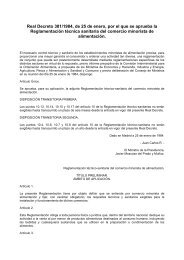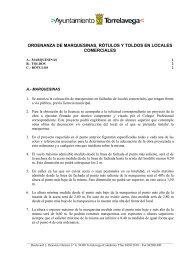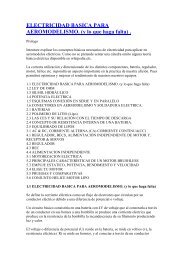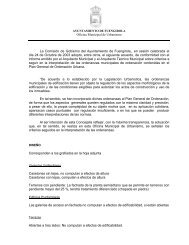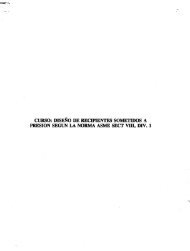- Page 1 and 2: 14 Diseño para Fatiga Instituto T
- Page 3: 6 CÁLCULO DE DAÑOS ..............
- Page 7 and 8: 5 MÉTODOS DE MEJORA Y REGLAS PARA
- Page 9 and 10: Lección 14.8: Conceptos básicos d
- Page 11 and 12: Lección 14.11: Análisis de tensio
- Page 13 and 14: 2.3.3 Propiedades del material ....
- Page 15 and 16: OBJETIVOS/CONTENIDO Resumir los fac
- Page 17 and 18: mayor parte de su vida propagándos
- Page 19 and 20: Resistencia a la fatiga N/mm 2 (a 1
- Page 21 and 22: Carrera de tensiones Δ σ (N/mm 2
- Page 23 and 24: 4. PARÁMETROS DE TENSIÓN POR FATI
- Page 25 and 26: El primer paso consiste en descompo
- Page 27 and 28: 7. RESUMEN FINAL • La fatiga y el
- Page 29 and 30: OBJETIVOS/CONTENIDO Introducir los
- Page 31 and 32: 2. CARACTERÍSTICAS DE LAS SUPERFIC
- Page 33 and 34: sino que la propagación se produce
- Page 35 and 36: Estado I Superficie libre Direcció
- Page 37 and 38: 4. CARGA DE FATIGA La forma más si
- Page 39 and 40: 5. DATOS DE LA VIDA A LA FATIGA Es
- Page 41 and 42: Apoyo principal Motor Acoplamiento
- Page 43 and 44: vagones a escala natural, y tambié
- Page 45 and 46: En el caso de componentes de la vid
- Page 47 and 48: diagrama S-N con R = constante o co
- Page 49 and 50: la entalladura, es decir, que una e
- Page 51 and 52: tensión de la figura 25a, un valor
- Page 53 and 54: Tensión alterna, S a Vacío su efe
- Page 55 and 56:
7. PROCEDIMIENTO DE RECUENTO DE CIC
- Page 57 and 58:
miento a través de cada siguiente
- Page 59 and 60:
dad de que las cargas más pesadas
- Page 61 and 62:
daños calculados se producen en lo
- Page 63 and 64:
con respecto a los efectos de la fr
- Page 65 and 66:
7. O. Ørjasæter et al, “Effect
- Page 67 and 68:
OBJETIVOS/CONTENIDO La identificaci
- Page 69 and 70:
de unión con la peor de las geomet
- Page 71 and 72:
3. SOLDADURAS A TOPE TRANSVERSALES
- Page 73 and 74:
tante, debe señalarse que se trat
- Page 75 and 76:
un riesgo de embridamiento de las s
- Page 77 and 78:
las cifras ofrecidas anteriormente.
- Page 79 and 80:
5. INSPECCIÓN Puesto que la resist
- Page 81 and 82:
haz se determina mediante la locali
- Page 83 and 84:
7. CONSIDERACIONES DEL DISEÑO La m
- Page 85 and 86:
ESDEP TOMO 14 DISEÑO PARA FATIGA L
- Page 87 and 88:
1. INTRODUCCIÓN Las secciones huec
- Page 89 and 90:
geométrica. Por lo tanto, el prime
- Page 91 and 92:
Deformación unitaria medida La vid
- Page 93 and 94:
Para otros espesores, resulta neces
- Page 95 and 96:
Estructura Carga en un diagrama de
- Page 97 and 98:
4. OTROS MÉTODOS Tanto en la bibli
- Page 99 and 100:
Figura 11 Modelo de subestructuras
- Page 101 and 102:
7. COEFICIENTES PARCIALES DE SEGURI
- Page 103 and 104:
9. RESUMEN FINAL • El comportamie
- Page 105 and 106:
OBJETIVOS/CONTENIDO Proporcionar in
- Page 107 and 108:
2. MODELACIÓN DE LA ESTRUCTURA Par
- Page 109 and 110:
No obstante, en el caso de los mome
- Page 111 and 112:
CONEXIONES EXTREMO CON EXTREMO Deta
- Page 113 and 114:
CONEXIONES EXTREMO CON EXTREMO Deta
- Page 115 and 116:
Coeficiente de la concentración de
- Page 117 and 118:
CCT 24,0 20,0 16,0 12,0 8,0 4,0 y e
- Page 119 and 120:
CCT τ = 0,5 τ = 1,0 caso del cord
- Page 121 and 122:
CCT MÉTODO DE LA TENSIÓN GEOMÉTR
- Page 123 and 124:
CCT CCT τ 0,75 20,0 16,0 12,0 8,0
- Page 125 and 126:
5. MÉTODO DE CLASIFICACIÓN El mé
- Page 127 and 128:
6. REQUISITOS GENERALES PARA LAS SO
- Page 129 and 130:
ESDEP TOMO 14 DISEÑO PARA FATIGA P
- Page 131 and 132:
126 A ( -b ) σmo = . 1 l o 1 σa 1
- Page 133 and 134:
2. DETERMINACIÓN DE LA RESISTENCIA
- Page 135 and 136:
ESDEP TOMO 14 DISEÑO PARA FATIGA L
- Page 137 and 138:
1. INTRODUCCIÓN 1.1 Generalidades
- Page 139 and 140:
(b) Alteraciones metalúrgicas en e
- Page 141 and 142:
(a) Reducir el coeficiente de conce
- Page 143 and 144:
GRUPO MÉTODO VENTAJA DESVENTAJA CO
- Page 145 and 146:
Campo total de deformación Noruega
- Page 147 and 148:
Carrera de tensión, MPa de tipo C-
- Page 149 and 150:
te las tiras Almen, que son pequeñ
- Page 151 and 152:
5. MÉTODOS DE MEJORA Y REGLAS PARA
- Page 153 and 154:
obtienen en la zona de ciclos grand
- Page 155 and 156:
[13] Haagensen, P.J. et al.: “Siz
- Page 157 and 158:
OBJETIVOS Introducción al diseño
- Page 159 and 160:
2. COMPORTAMIENTO ANTE LA FATIGA DE
- Page 161 and 162:
2.4 Comparación entre la Resistenc
- Page 163 and 164:
F b 2F c 2F t 2F t F b ficies en co
- Page 165 and 166:
Fb (kN) 150 100 Fv Fc 45 o 2F t 2F
- Page 167 and 168:
4. FATIGA DE UNIONES ATORNILLADAS C
- Page 169 and 170:
5. CURVAS DE CÁLCULO DE FATIGA PAR
- Page 171 and 172:
7. RESISTENCIA A FATIGA DE LOS TORN
- Page 173 and 174:
ESDEP TOMO 14 DISEÑO PARA FATIGA P
- Page 175 and 176:
1. RESUMEN 174 Una barra tubular a
- Page 177 and 178:
3. COMPROBACIÓN DE LA RESISTENCIA
- Page 179 and 180:
4. CÁLCULOS DE LA VIDA A LA FATIGA
- Page 181 and 182:
180 4.2.3 Apriete del tornillo A co
- Page 183 and 184:
5. CONCLUSIONES 182 La unión tubo/
- Page 185 and 186:
ESDEP TOMO 14 DISEÑO PARA FATIGA L
- Page 187 and 188:
1. INTRODUCCIÓN La rotura por fati
- Page 189 and 190:
- n ⎛ n ⎞ ⎛ n ⎞ ⎛ n ⎞
- Page 191 and 192:
n. ∑ x b = 1. y1- ∑ x1. ∑y1 =
- Page 193 and 194:
194 Tipo de Detalle Campo de la des
- Page 195 and 196:
te (se asume que, en aras de la sim
- Page 197 and 198:
decisión acerca de la elección ad
- Page 199 and 200:
4. RESUMEN FINAL • Las opiniones
- Page 201 and 202:
OBJETIVOS/CONTENIDO Esta lección c
- Page 203 and 204:
2. IMPLICACIONES PRÁCTICAS DE LOS
- Page 205 and 206:
Para una sección de una barra pris
- Page 207 and 208:
3. ESPECTRO DE LA TENSIÓN PREVISTA
- Page 209 and 210:
4. CONCEPTO DE LA CLASIFICACIÓN DE
- Page 211 and 212:
y para Δσ c = 1000 MPa log a = 6,
- Page 213 and 214:
6. REGLA DEL DAÑO ACUMULADO, CONCE
- Page 215 and 216:
donde: N equ es el número equivale
- Page 217 and 218:
En reconocimiento a este comportami
- Page 219 and 220:
ESDEP TOMO 14 DISEÑO PARA FATIGA L
- Page 221 and 222:
1. INTRODUCCIÓN En la lección 14.
- Page 223 and 224:
un único emplazamiento, o que sean
- Page 225 and 226:
3. NOTAS SOBRE LAS FIGURAS DETALLAD
- Page 227 and 228:
c. Las tensiones se deben calcular
- Page 229 and 230:
d. Esta es una aplicación directa
- Page 231 and 232:
diente no superior a 1:4, mantiene
- Page 233 and 234:
FIGURA 5 ría se reduce a la 71). O
- Page 235 and 236:
d. Igual que para la figura 4a, not
- Page 237 and 238:
Figura 7 FIGURA 7a a. Estas soldadu
- Page 239 and 240:
FIGURA 7c suficientemente grande co
- Page 241 and 242:
esulta totalmente adecuado. Los ens
- Page 243 and 244:
4. RESUMEN FINAL • La clasificaci
- Page 245 and 246:
CONTENIDO CONTENIDO Problema Resuel
- Page 247 and 248:
2. CARGA Y CICLOS APLICADOS La grú
- Page 249 and 250:
4. CÁLCULOS DE LAS TENSIONES Para
- Page 251 and 252:
Las carreras de tensiones de la sol
- Page 253 and 254:
5.2 Daños Bajo Carga Máxima Debid
- Page 255 and 256:
7. EVALUACIÓN PARA EL CARRO EN RET
- Page 257 and 258:
9. CONCLUSIÓN Debido a la limitaci
- Page 259 and 260:
OBJETIVOS/CONTENIDO Introducir los
- Page 261 and 262:
2. ANTECEDENTES DE LA MECÁNICA DE
- Page 263 and 264:
3. EFECTOS DEL MODO DE CARGA La des
- Page 265 and 266:
c c de la superficie libre. Por lo
- Page 267 and 268:
tensión cambiante. Dos importantes
- Page 269 and 270:
7. LA IMPORTANCIA DEL COEFICIENTE D
- Page 271 and 272:
ESDEP TOMO 14 DISEÑO PARA FATIGA L
- Page 273 and 274:
1. INTRODUCCIÓN Todos los elemento
- Page 275 and 276:
narias de una función analítica y
- Page 277 and 278:
3 RANGO DE TENSIÓN ELÁSTICO EN EL
- Page 279 and 280:
Para la teoría de la deformación
- Page 281 and 282:
5. MODELO DE LA FLUENCIA DEL FRENTE
- Page 283 and 284:
6. RESUMEN FINAL Para un rango de t
- Page 285 and 286:
ESDEP TOMO 14 DISEÑO PARA FATIGA L
- Page 287 and 288:
1. INTRODUCCIÓN En la lección 14.
- Page 289 and 290:
2. SOLUCIONES ANALÍTICAS En la lec
- Page 291 and 292:
3. EL PRINCIPIO DE BUECKNER Y LAS F
- Page 293 and 294:
de tensión consiste en determinar
- Page 295 and 296:
de intensidad de tensión a partir
- Page 297 and 298:
306 PROBLEMAS DE GRIETAS ko = σ π
- Page 299 and 300:
308 1 CASO COEFICIENTE DE LA F G CO
- Page 301 and 302:
6. EFECTOS DE LA PLASTICIDAD Tal y
- Page 303 and 304:
APÉNDICE APÉNDICE 313
- Page 305 and 306:
316 (d) Coeficiente de Corrección
- Page 307 and 308:
OBJETIVOS/CONTENIDO Resumir los fac
- Page 309 and 310:
2. COMPORTAMIENTO DE LA PROPAGACIÓ
- Page 311 and 312:
t La investigación llevada a cabo
- Page 313 and 314:
Si cada uno de los diferentes bloqu
- Page 315 and 316:
a f ⎡ 2 ⎤ ⎢− ⎥ ⎣ a ⎦6
- Page 317 and 318:
7. RESUMEN FINAL • Generalmente,
- Page 319 and 320:
OBJETIVOS/CONTENIDO Introducción a
- Page 321 and 322:
Las prácticas actuales conllevan l
- Page 323 and 324:
Con el fin de prevenir una grietaci
- Page 325 and 326:
que, incluso aunque se produzca el
- Page 327 and 328:
número de datos de ensayos y de ag
- Page 329 and 330:
2.2 Efectos del Comportamiento de l
- Page 331 and 332:
Longitud de la fisura a i Material
- Page 333 and 334:
Coeficiente de carga n z tuales (po
- Page 335 and 336:
Longitud de la fisura a a i Figura
- Page 337 and 338:
5. BIBLIOGRAFÍA ADICIONAL 1. Fishe
- Page 339 and 340:
OBJETIVOS/CONTENIDO Mostrar los mé
- Page 341 and 342:
2. DESARROLLO DEL PERFIL DE LA GRIE
- Page 343 and 344:
procedimiento para un nuevo increme
- Page 345 and 346:
de profundidad. En el caso de una p
- Page 347 and 348:
o o Kr √δr √Jr 1,0 0,8 0,6 0,4
- Page 349 and 350:
5. TRATAMIENTOS AVANZADOS En otras
- Page 351 and 352:
DIAPOSITIVAS COMPLEMENTARIAS DEL TO
- Page 353:
370 T14c9 Grieta de fatiga producid



